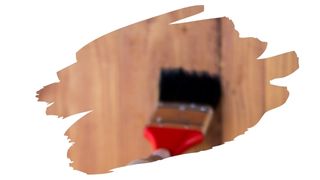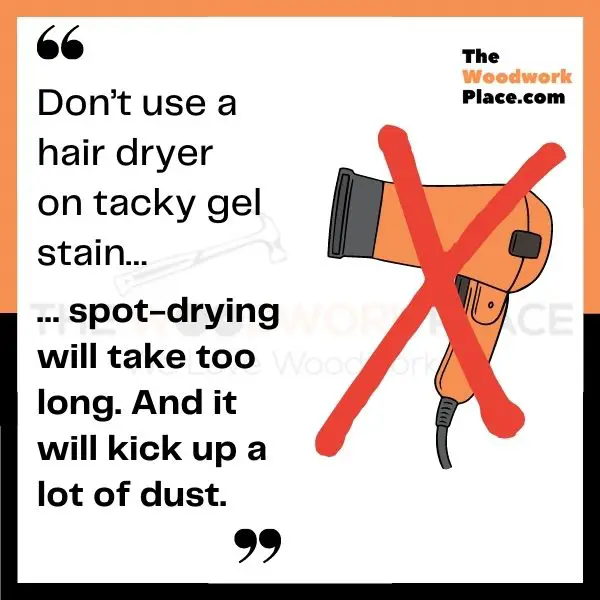Are you starting to feel frustrated, waiting and waiting for that gel stain coat to hurry up and dry?
You may have an issue with tacky gel stain, but the problem might not actually be what you think it is.
Gel stain usually takes less than 24 hours to dry enough for another coat. But what if you’ve been patient enough to find yourself still waiting for it to dry some 48 – or even 72 – hours later?
Well, before you get desperate enough to use a blow dryer on it, why not give our post below a quick read.
That’s because, in this post, you will learn why a tacky gel stain problem can’t be solved with a simple hair dryer. You will also learn why a contaminate could be preventing your gel stain from drying evenly.
And we reveal how to fix, (or even remove), a tacky gel stain coat that refuses to dry at all…

This post may contain affiliate links to products that we receive a commission for (at no additional cost to you). Learn more here.
How Long Should It Take For Oil (Or Water) Based Gel Stain To Dry?
Well, water based gel stains take around 2-3 hours to dry. And a specially formulated fast drying gel stain product can take as little as 60 minutes to dry enough for a 2nd coat.
However, oil based gel stains take much longer, in comparison. These solvent-based gels take anywhere from 12 to 24 hours to dry.
But it is pretty typical of oil based finishes, in general, to take longer to dry. As water based finishes can complete the evaporation process much more efficiently (due to all of that H2O).

So, Why Is That Gel Stain Not Drying? (Top 3 Gel Stain Problems)
There are three main reasons why a gel stain coat just won’t seem to dry; time, contamination, and excess gel stain.
Gel Stain Problem 1: Time
This is the easiest problem to solve out of the three. That is because all you need to do is turn up the heat and wait a little longer.
You see, the drying time listed on that gel stain product is highly dependent upon ideal temperatures and humidity.
In optimal conditions, gel stain will take less than 24 hours to dry. But those optimal conditions require temperatures to be between 40 °F to 90 °F (for an oil-based gel stain). If its colder than that, it will take longer to dry.
In addition to this, too much moisture in the air can effect drying times too. An optimal humidity level for gel stain to dry is 40-50% relative humidity. However, if humidity levels reach beyond 85%, then gel stain is going to struggle to dry (if at all).
Related Post: Should You Try Mixing Gel Stain With A Penetrating Wood Stain?
And How Do You Solve The ‘Time’ Problem? Turn Up The Heat
You can fix this problem by turning up the thermostat and bringing in a dehumidifier. The dehumidifier will bring down humidity levels (if need be). And a warmer room will help speed things up.
After which, give that gel stain another 24 hours to dry.
Can You Use A Hair Dryer To Dry Gel Stain?
This might seem like a no-brainer of a solution, but you should avoid getting out that hair dryer.
You see, there are two problems with this drying method; practicality and dust.
If you are working on drying a large gel stained surface area, spot-drying is going to take forever. Next, all of that air getting blown around is going to kick up a lot of dust.
And the last thing you want are dust nibs getting caught up in that still-wet gel stain.
Related Post: Are There Dust Nibs In Your Polyurethane Finish? (How To Fix It)
Gel Stain Problem 2: Contamination
This problem is a little different to the time issue. When gel stain is evenly tacky across the surface, then time is likely your issue.
However if gel stain is dry in spots, but tacky in other areas, then it’s possible you have a ‘contamination’ problem.
Now, what we mean by this is that the natural wood underneath has some kind of chemical substance in it that’s preventing gel stain from drying evenly.
As a result, the sections that have the contamination spots are preventing gel stain from drying as it should.
For example, wood wax can prevent gel stain from drying. So, if you’re refinishing a previously waxed furniture item with a gel stain coat, there may still be some wax in certain sections.
Worse still, that old wax can cause adhesion problems. So, even if that tacky gel stain eventually dries, it will start to peel off later on anyway.
Related Post: 7 Surprising Advantages (And 6 Disadvantages) Of Wax Finishes On Wood
And How Do You Solve The ‘Contamination’ Problem? Remove And Reapply
You can solve this by removing the gel stain coat completely, and starting all over again.
It is time-consuming (and finicky) to spot-correct an unevenly drying gel stain coat.
So, instead, remove the gel stain altogether using a stripping gel. Scrape it off with a putty scraper. And make sure you get the last of it by sanding the surface smooth once again.
Once you’ve got back down to bare wood, clean the natural surface with mineral spirits, before reapplying.
For a quick and easy visual guide to removing gel stain, check out DIY Power Couples video on removing Gel Stain using a stripping gel product.
Gel Stain Problem 3: Excess Gel Stain
You must always use a rag to wipe off excess gel stain (between each coat).
Even if you apply gel stain using a brush, (as opposed to using a rag), you still need to go over each brushed coat with a rag anyway.
Sure, that brush will have applied the gel stain thinly enough. However, you can only remove all excess gel stain by rubbing it out with a rag afterward.
Simply leaving gel stain to sit, (after brushing), is a sure fire way to end up with a tacky finish.
Related Post: Will Mineral Spirits Be Enough To Remove Gel Stain?
And How Do You Solve The ‘Excess Gel Stain’ Problem? Remove The Excess
You can try ‘thinning’ the tacky gel stain out a little, using mineral spirit.
Lightly dampen a lint-free rag with mineral spirit. And then run it over the gel stained surface. Once that gel stain softens and thins-out, you can remove it with a rag, wiping it right off.
Any excess gel stain that won’t wipe off can be scraped off using a putty scraper tool (like the one shown in the image below).

Failing that, if this method doesn’t smooth out that gel, then you’ll simply have to remove and reapply the stain altogether.
Will Tacky Gel Stain Eventually Dry On It’s Own? That all depends on what’s preventing it from drying. It may never dry if the weather is too cold/humid, or there are chemical contaminates in the wood underneath.
Can You Simply Apply Polyurethane Over Tacky Gel Stain Anyway?
Putting anything over a tacky gel stain is a bad idea, due to something called Offgassing.
Offgassing, (sometimes interchangeably referred to as outgassing), refers to the fumes released from solvent-based substances.
Varnishes, paint, and oil-based finishes in particular, all release fumes (also known as VOC’s – Volatile Organic Compounds) into the air as they dry.
That stuffy chemical whiff coming from that open can of gel stain? That’s offgassing in action.
Now, we all know these fumes get released as we wait for gel stain to dry throughout those 24 hours. What you may not know, however, is that off gassing continues long after you stop smelling those fumes.
Basically, as long as gel stain hasn’t wholly dried, (i.e. it is still tacky), then those VOC gases will continue to get released into the air (although in smaller quantities).
So, if you apply poly over tacky gel stain, those fumes will continue to release. Except now they are getting trapped underneath a poly top coat. And this, in turn, will cause adhesion problems as that gaseous build-up will push that polyurethane up off the surface.
In short, fix tacky gel stain first before applying any sealing finish (including polyurethane) over it.
Related Post: Can You Put Polyurethane Over Gel Stain? (Best Practice Revealed!)
To Wrap Up, Here Are The 3 Main Takeaways…
- 1). If that gel stain isn’t drying, then turn up the heat (and the dehumidifier).
- 2). If that gel stain is drying unevenly, (and is only tacky in spots), then there may be some contaminant in the wood underneath.
- 3). In which case, remove gel stain using mineral spirits or a stripping gel, and then reapply.
Related Post: Can You Apply Wood Stain Over Wood Hardener? (Best Practice Revealed!)
References:
Temporal variation of VOC emission from solvent and water based wood stains | Science Direct

![Will Tacky Wood Stain Eventually Dry? [What To Do When Stain Is Not Drying] will tacky stain eventually dry](https://www.thewoodworkplace.com/wp-content/uploads/2022/10/Banner-502-150x150.jpg)

